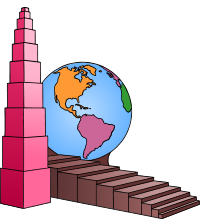
At the heart of the Montessori curriculum is the understanding that each child learns differently and their education needs to be unique to their needs. While there are a number of distinctions between Montessori schools and traditional daycare or child care centers, the following are a few of the more prominent ones:
| Montessori Program | Traditional Daycare or Child Care Center |
| Teacher has an unobtrusive role in classroom activity; gives primarily individual lessons with children working independently. | Daycare teacher is the central figure in classroom activity; mainly entire group lessons with all children doing the same activity at the same time. |
| The environment and method encourage internal self-discipline. Self-motivation is the goal. | External forms of discipline –rewards and punishments—are used as motivators. |
| Child works at his/her own pace to internalize information. | Instruction pace is usually set by the group norm or teacher. |
| Research-based materials are used for physical and intellectual exploration. | Toys are often used to entertain and teach in daycare centers. |
| Child spots her/his own errors through feedback from the material not adult correction. | Errors are pointed out and correction is usually given by the adult. |
| Children choose their own work based on their own interests and abilities. | Curriculum is structured for the group with little variance for individual interests. |
| Three-year, mixed aged environment | Children grouped by age |
| Children work where they are comfortable, move around as needed and talk to one another at will while learning to respect each other’s need for independent work. | Children are usually assigned their own table and chair or rotated through activities. They are often encouraged to sit still and not talk. |
| Montessori schools use specifically designed educational material to intrigue, challenge and promote education across a multitude of subjects. | Daycare centers use toys with little to no educational value. |

You must be logged in to post a comment.